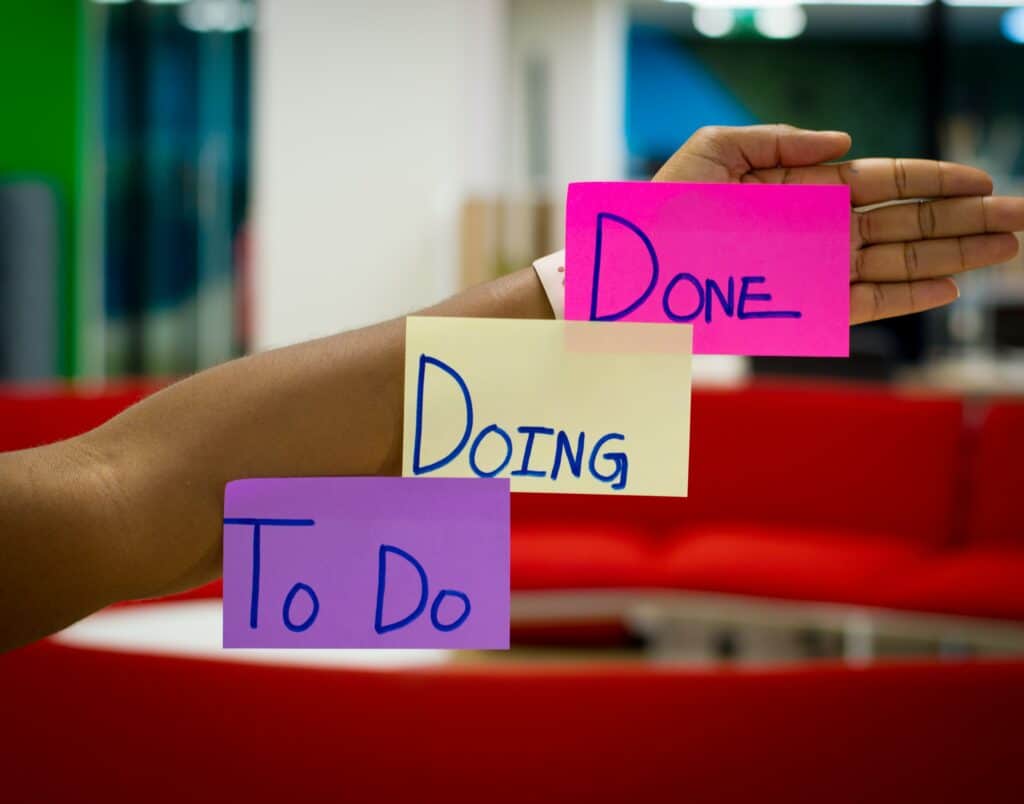
There are a number of workshops to illustrate the Kanban method. However, most of them are long (at least 2 hours) and require specific equipment to be animated in a relevant way. I speak in particular of GetKanban, Kanbanzine or even Kanban Pizza Game.
I have since discovered Featureban (eng), created by mike burrows, which I particularly appreciate. Indeed, it is a workshop that I had the opportunity to facilitate during theAgile Tour Toulouse 2019, in 45 minutes.
I share with you here in detail the way I animate it today and a little more! ;-).
Nice reading to you!
Material
In terms of material for a animation in physics, here is what we will need:
| What ? | How much ? | To do what ? |
|---|---|---|
| Carton / A3 sheets | 2 per team / 3 per team | View tables or results |
| Mini post-its | 1 packet per person | Materialize work items (and potentially waste less paper) |
| Markers Or Felt pens | 1 per person | To write on mini post-its |
| Coins | 1 per person | Simulate our days |
Optional: mini post-it of different colors (2 colors are enough)
For a online animation, we will especially need a digital whiteboard (Miro / Mural / Klaxoon type…) and an application of the type justflipacoin.com to simulate days. You can also ask each person to find a piece to do it by hand. I observed that people preferred to do it really from elsewhere, even from a distance 🙂
Preparation
In terms of preparation, I tend to prepare at least the following 3 elements:
1. Visual Management
I usually draw by hand on Paperboard or A3 sheet the following table:

- Loan could also be called Backlog
- Achievement and Validation have been put as an example and could very well be called " Step 1" And " 2nd step“. The importance is above all to divide the column In progress in 2
- If you want to give the participants some control, you can leave the choice of naming to them. For my part, I tend to ask them to save time because nothing is played on it. In addition, the terms Realization and Validation are more easily transferable in most contexts (IT and non-IT) unlike Development and Testing
- If you prefer, you can also print this version
2. Control Card

- We do not know the results in advance so this preparation is simply logistical. We might as well do it on the spot if needed.
- # Element means Item number in the sense that we seek to represent each element of work on the abscissa axis.
3. Scoreboard and day tracking

- The first part will be used to visualize the results of the first round to be able to carry out a first debriefing. In an alternative animation, we use this table twice in order to make a comparison between 2 rounds with different rules.
- The second part will be used by participants to follow the number of their current day. Indeed, this will allow us to better visualize the time elapsed thereafter.
Animation
The version of the workshop that I propose to you takes place in 2 rounds. There will simply be a change of rules between these 2 rounds which will allow us to see the differences in terms of feelings and results.
The biggest challenge of animation is therefore in the explanation of the initial rules.
A bit like in any board game, this is when you will have to be both simple and precise.
Let's see together how we can do this.
Explain the rules of the game
To explain the rules, you have several options: either you rely on a visual support, or you explain it orally.
The advantage of the first method is that it will be visual and can help understanding. The second is useful in particular when you do not have the visual support available: it is therefore necessary to proceed step by step to be effective. So I will describe the 2nd approach below.
My explanation takes place in 2 parts in order to properly sequence the information.
Part 1: Setup
We start here with the easiest elements to share.
AT - Visual management board
We will use this support to visualize the work carried out by the team. As you can see, it consists of a flow with 3 main stages: Ready, In progress (which is divided into 2) and Done.
B – Post-it Backlog
We'll consider the Ready column to be an endless list of work to do. You can already fill it if you wish, the important thing is to keep in mind that if it empties, you will have to fill it again (unless otherwise indicated).
In the initial version of Mike Burrows, he made the participants think about the functionalities of a merchant website which were then written on the post-its (in the center). I made the choice to remove this step and simply consider each post-it as work to be done. The filling of the Ready column is therefore done in my case with empty post-its.
C – Information on post-it notes

I would ask you to write different information on this post-it:
– Top left, your initials : so we will always know who is working on what,
– Bottom left, a B : if your work gets stuck because sometimes things don't go as planned. If your job is unlocked, you can simply cross out the B,
– At the top right, the start date : the number of the day you started working on this item (moving the column Ready to the first column ofIn progress),
– Bottom right, the end date : the number of the day you completed the item (moving the second column fromIn progress To Ended)
You can take a sample post-it note to support the speech or fill one out on the spot. I tend to explain this orally but that's me 🙂
I end by saying:
Moreover, I suggest that you draw a first item of work per person in the first column of In-Progress. You can write your initials at the top left. This will be the initial state of our system.
The idea here is to make a first pass on the playing space in order to make a second reminder loop by explaining the rest of the rules.
Part 2: Game mechanics
Good or bad day
Now let’s get into the decision-making rules:
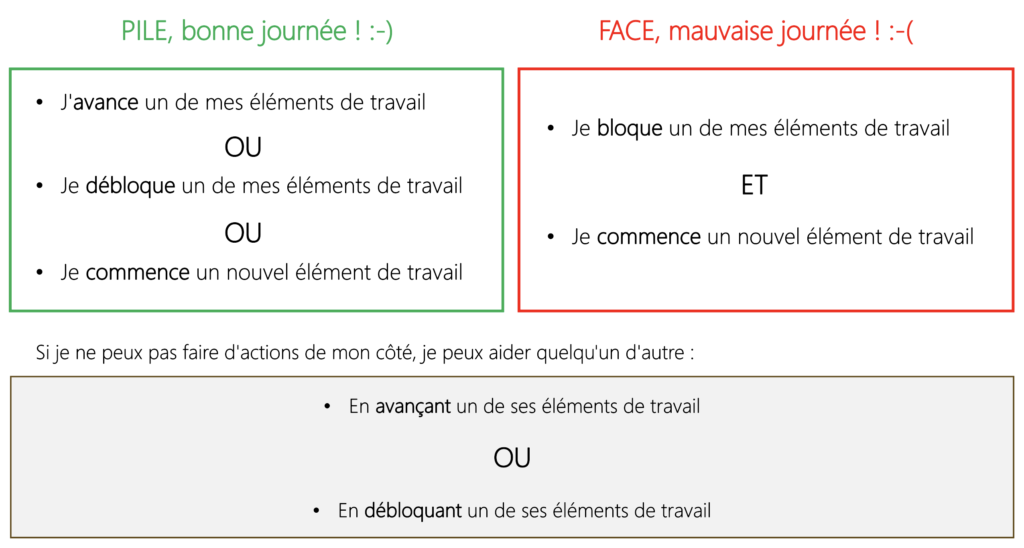
To give some meaning to these rules, here is a way to present them:
We are going to simulate the fate of a coin toss day.
(PILE)
Sometimes you can have a good day, where things go well. We can then advance our subjects, unlock an element (cross out a B) or start a new one!
(FACE)
Sometimes it's the opposite, it's a day where you find yourself stuck without being able to do anything (write a B). However, in order not to remain inactive, we will start a new task!
The important thing here is to emphasize the OR have a good day and on the AND of the bad day.
Indeed, this is what will allow us to highlight thestacking of ongoing tasks. Event not far from the working habits of most corporate settings.
Subsidiary rule
Then comes the subsidiary rule:
If you are unable to perform an action (neither in Heads nor Heads), then in this case you can help one of your colleagues by advancing or unlocking one of his elements.
It often happens here that people react by indicating that this rule will never be applicable. I then tell them that they are potentially right, but it has the merit of existing! 😛
essential rule
I then specify that a rule is essential to respect:
First with me, then with others.
This means that if I can perform an action on one of my tasks then it takes precedence over a potential action on a task of one of my colleagues.
Keep track of time

Finally, I tell them that each lap will be recorded to properly materialize the time that passes. To do this, each team will have to note and increment the number of the day. We will start with number 1 for the first round. In the example above, the team is on day 5!
Some teams cross out each day as it goes, that's totally ok 🙂
Round 1: Start
When each person has their piece and each team is in front of their visual management, we can start.
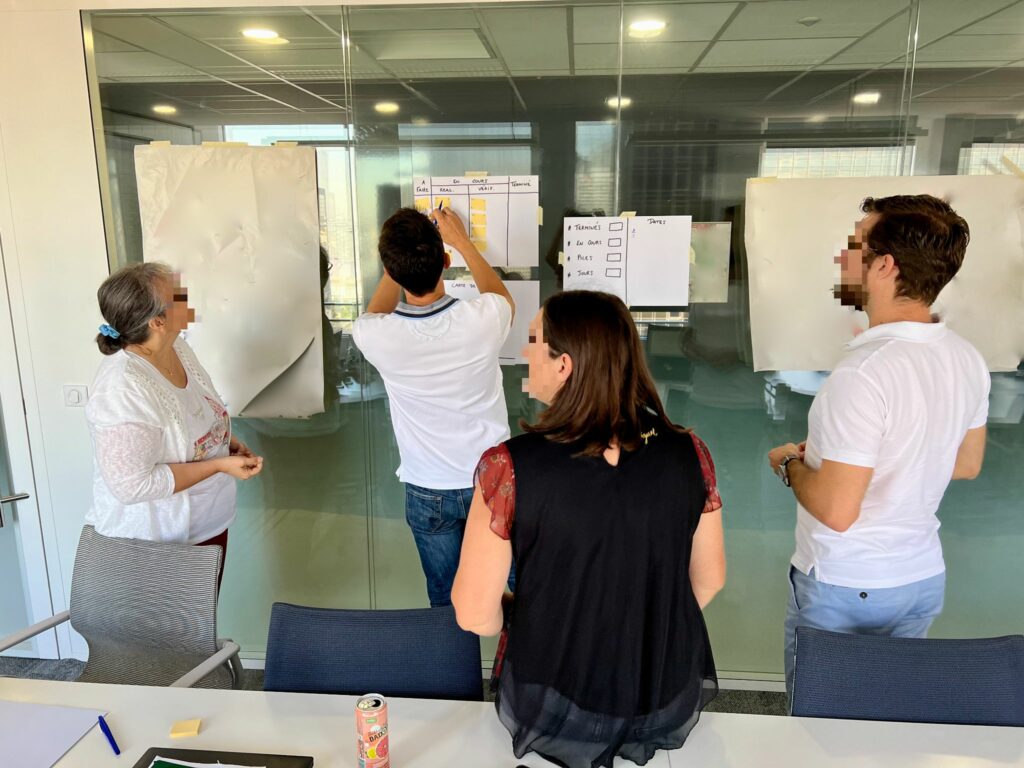
I tend to pay attention to the first laps, especially in case of a bad day. The important thing is to make sure that when a block is made, that a new element is also started. We can therefore always give meaning to the action to prevent this movement from being simply mechanical.
When I'm stuck, I'm not going to sit idly by so I start something else.
Turn 1: Stop
As in many Kanban workshops, there is no predefined time. It is therefore up to the facilitator to determine when the round will end. There are then different alternatives:
| Alternatives | Learning intention | Comments | |
|---|---|---|---|
| 1 | time limit (ex: about 10′) | Flow state according to different rules per time period | Simple for facilitation. The table may be too full or too light for the debriefing. It depends on how quickly the team gets to grips with the exercise. |
| 2 | Limitation in number of days (ex: 10 days Max) | Time to unstack is far greater than time to stack | Simple for facilitation and for participants. The result of each team will be different hence the importance of choosing a sufficient number of days to have consistency. |
| 3 | Limitation in number of current elements in the first column (ex: 10 Max) | Focus on bringing limits to interactions | Simple and fast for the facilitation and for the participants. Can stop very quickly depending on the number of people in the team. |
The learning intentions described above are not hermetic. They are an indication to anticipate the course and the most direct debriefing but nothing will prevent to approach the other notions! 😉
In the example below, I chose to limit in number of days (about 10).
Note: I think that in the future and to limit the playing time, I will rather limit the number of current elements in the first column 🙂
Round 1: Results
When the tour ends, I first invite the participants to fill in the following table:
| Wording | Description |
|---|---|
| # Completed | Number of items in the Completed column |
| # In progress | Number of items in the In progress column (sum of the 2 sub-columns) |
| # Batteries | Number of “Stacks” required to be able to pop out all the In Progress elements |
| # Days | Matching in number of days: divide # Stacks by the number of players on the team |
Potential help for # Batteries:
- Count 1 per element in the third column
- Count 2 per element in the second column
- Count 1 per element blocked
You will have obviously noticed that the order specified above invites the participants to read their table from right to left, right? 😉
Here are the kind of results obtained:
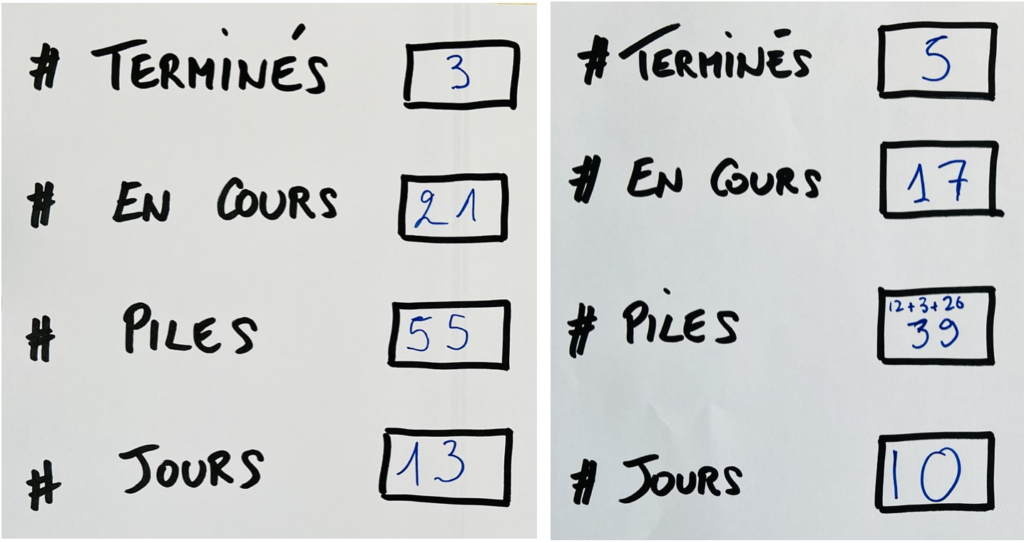
Round 1: Debriefing
For my debriefing, I tend to start from the results first. Indeed, it creates coherence with the previous instructions and therefore does not cut the narrative flow.
Workflow Trends
What matters is not really the content but the trend of the results obtained. So what should emerge should look something like this:
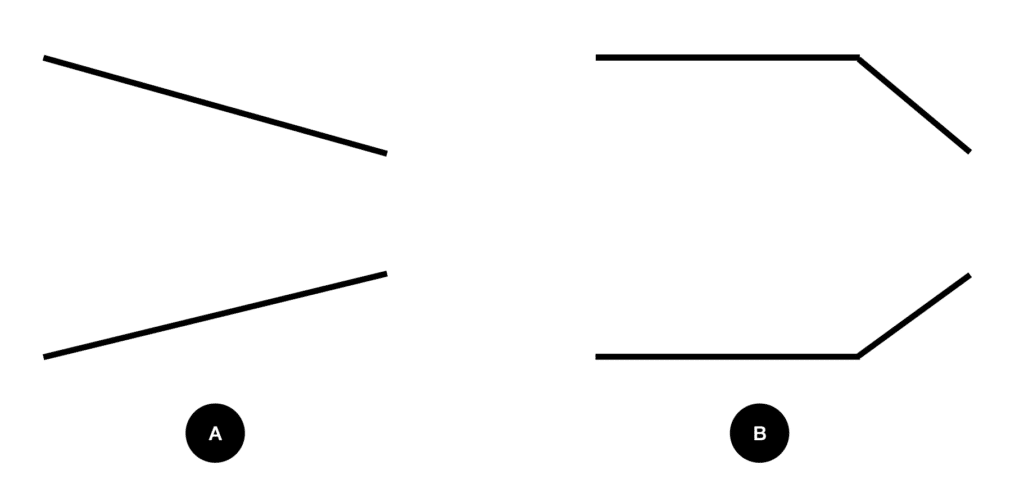
The idea behind these trends is that the number of in-progress items is much more important than the number of completed items. This is often representative of an overload and therefore of a lack of balance between demand and capacity to do. The difference between case A and case B is simply a matter of the magnitude of the overload.
To visualize it differently, here is a way to represent case B below:
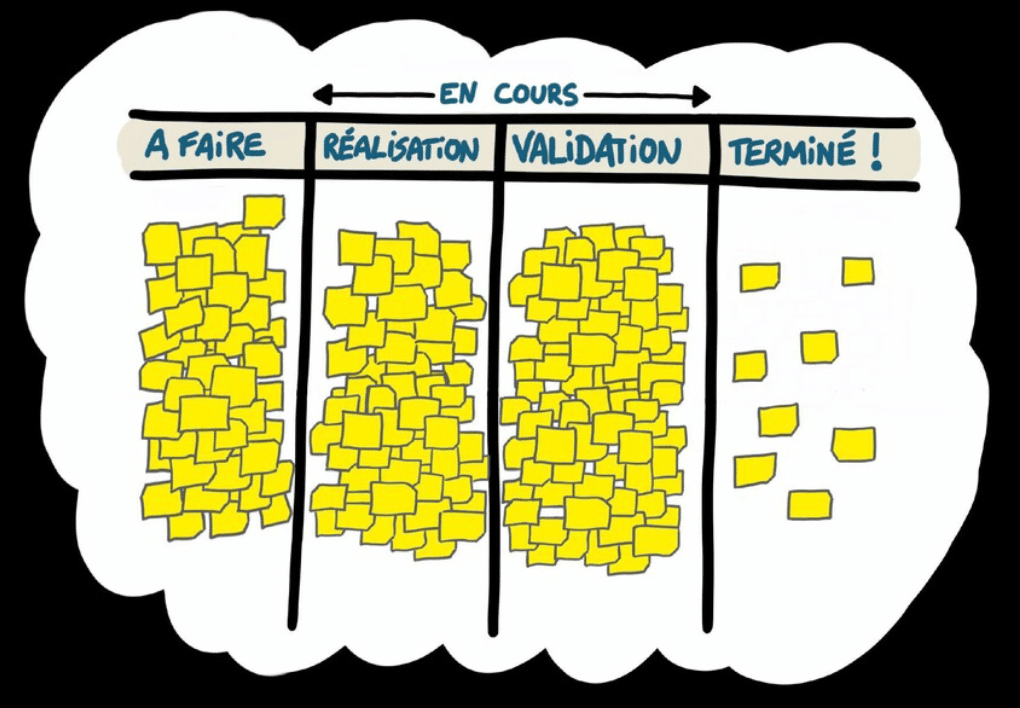
Looking at the results, we see that we have this trend:

I then ask the participants:
Does this trend sound familiar to you?
Generally, nods will rather answer positively to this question.
Losing strategy?
Previous results can be an opportunity to discuss why people tend to take on new things and pile on the work. This can provide context and generate good conversations.
We can then continue with:
Do you think that by continuing in this way you will be able to unstack all your work in progress?
I generally rely on the results obtained previously:

We see here that it would take at least 10 good consecutive days, for all the members of the team (about 4 people in this case), to hope to unstack. So it seems impossible. Participants generally agree with this sad observation.
And collaboration in all this?
That's sometimes how I approach the subject 🙂
We will focus here on how everyone made their action decisions at each turn.
Some people may feel like they have collaborated together. However, this collaboration is illusory. Indeed, in view of the rules set out, no one needs others to make decisions and everyone advances on their own tasks. They actually don't even need to talk to each other and could have done the exercise individually in their corner.
The only elements of collaboration are potentially: the collective understanding of the rules and the launch of each day together (and again this last point is not always true).
So, in this strategy, is not the collaboration that is encouraged but the individual performance.
We can then move on to Round 2 🙂
Debriefing alternatives
Before embarking on the debriefing of the results, you can also start with these avenues:
How did it go for you? 🙂
A first phase of standard debriefing is in my opinion always a good practice. The question may differ but the main idea is to see what emerges from the experience of the participants. We " drawn » then the information rather than the « push » 🙂
Do you see familiar elements from your work experience? New?
A second context-oriented question this time. It can be complementary to the previous one and allows you to see if people manage to take a step back from what has just happened. We can then introduce the information mentioned above.
Round 2: Start
For this second round, I invite participants to put limits on each sub-column ofIn progress.

Arbitrarily, I often propose a limit of 3 or 4 for each of the sub-columns.
It mainly depends on the fill load of the first WIP column. To prevent the workshop from lasting too long, it is better to raise the number a little to make it more fluid. In this case, I set the slider to 4. Otherwise generally, I keep it at 3.
Then I explain the meaning of the limits:
The number written at the top of the column corresponds to the maximum number of elements accepted in this column.
That's usually where some people react and understand that it's going to go to the subsidiary rule. Indeed, the limits will prevent them from performing actions which will encourage mutual aid in the team.
Turn 2: Stop
In this Round 2, I propose to the teams to stop:
After delivering 10 new items through this limited system.
This means that they must first pop the current elements to free up the space needed to pass through the 10 additional elements.
I then suggest that they annotate them from A to J in order to be able to recognize them. You can also use mini post-its of different colors if you have that on hand. The idea will be to be able to compare the crossing time of these new elements compared to the others.
Round 2: Facilitation
While Round 1 didn't require much action on my part as a facilitator, Round 2 is generally different. Indeed, the subsidiary rule will tend to generate some questions.
Questions
Here are the ones that tend to emerge:
I made "Heads" but I have no more elements of my own, am I blocking an element of someone else?
Of course not. Already you have a bad day, you don't have to share it with others! More seriously, we only block our own elements. In this case, blocking is therefore not possible.
I made "Face" and I have no more elements to me. Can I advance someone's work?
I recall here the essential rule: “First at home, then at others”.
So if I can start a work item because the limit allows me to, I perform that action. Otherwise, I can no longer perform an action at home so I can go and help a colleague.
Can an element be “advanced” several times in the same turn?
There I often hesitated but I ended up saying Yes. Indeed, it can very well happen that in the same day the whole team focuses on a single element to bring it out. This is also normally the case for "emergencies" or "expedite".
Strategy
At the individual level, it is interesting to observe the mode of decision-making. Indeed, in this second round, let us remember that each person normally leaves with a certain number of tasks to unstack.
When I do a "Head", I have at least 2 actions at my disposal: unlock an element and move an element from the 2nd column of work in progress to Done. Starting a new item and moving the 1st WIP column to the second are both blocked by limits.
Note: It may happen that the second column of work in progress is not too full and in this case the movement from the 1st to the 2nd column of work in progress will also be possible. We will, however, remain in the event that it is also overloaded.
The strategy that we seek to see emerge is the one that pulls items to Done ASAP.
Indeed, completing items will naturally free up space in the 2nd in-progress column to then free up space in the 1st in-progress column. And this, while avoiding as much as possible that an element gets blocked in the meantime and slows down our progress.
It is during the tour that I sometimes ask people about their strategy to depilate. It is not always very clear but it feeds the idea that there could be one. This often generates conversations around decision making and thus brings us to the next point. 😉
Collaboration ?
Unlike Round 1, we can see the emergence in some teams of real collaboration between people.
Indeed, they realize that theorder of actions may have an impact on the results obtained.
This generally takes the form of a joint toss of coins and a collective reflection to optimize actions.
When it doesn't come naturally, I can conjure up the idea to see if it helps. To leave people free to take or not, it is in the form of a question that I will invite them to reflect.
Round 2: Debriefing
For the debriefing of this round, you can start with a standard debriefing as in the previous round.
Otherwise, 3 subjects are in my opinion important to discuss:
There collaboration, THE crossing time and the time to unstack.
Collaboration
You can discuss the elements described above here, but in a large group.
Did you notice a difference between round 1 and round 2 in the way you interacted?
To make decisions?
This generally allows discussions around collective effectiveness to be opened up to focus on one element and bring it out together. A remark often emerges at this time:
The exercise assumes that we are all capable of doing everything, whereas in real life this is not the case!
It is totally true. However, the important thing is not in the fact that we are all capable of doing everything but in the attention that we have brought to work in our decision-making. Indeed, the limits push the team to see the work as a whole and not in a local or specialized way.
Each column is not reserved for a specialty but corresponds to a stage in the realization of the work element where everyone can contribute, whatever their function.
Now, even if we are not able to perform an action directly on the work to help a person, we may be able to help him in another way. This can be by looking for information or by reviving people in addiction. For example.
The important thing is therefore to work together to complete elements and
to delay the decision to start something new as much as possible.
Thus, it can be said that limits do not directly speed up delivery.
The limits are collaboration generators which consequently will accelerate the delivery.
Crossing time
Here we will draw the control chart of the system: the set of traversal times for each work item. To do this, I ask participants to subtract the end day number of an item from the start day number. We thus obtain the crossing time of the element in days 🙂
I also ask participants to separate the 10 new items that have passed through the limited system from the others. Indeed, it will facilitate the debriefing by visually structuring the results.

We see here on the left the first elements having crossed the system initially not limited. On the right, the 10 elements that passed through the limited system.
From these results, we can then deduce 2 contributions of the limitation of work in progress:
THE average crossing time is better and thestandard deviation is lower.
So it will be easier to be predictable in this setup.
Note 1: to improve rendering, I think it might be useful to number the work items from the start. Thus in the representation of the control chart, from the implementation of the limited system, one should see a reduction in the crossing time.
Note 2: to create a habit within the team, we can also suggest that they fill in the control card as they go along. It can then start from Turn 1.
To help with this, we could use something like this:
| # Element | Start date | End date | Crossing time |
|---|---|---|---|
| 1 | 1 | 9 | 8 |
| 2 | 3 | 10 | 7 |
| 3 | 4 | 8 | 4 |
For the occasion, I made the painting in downloadable pdf.
Time to unstack
As mentioned earlier in this article, the fact of stopping Turn 1 in number of days is intended to speak of the time to pop. Indeed, you will realize that Round 2 is much longer and more laborious than Round 1. This is the desired effect.
Let's look at the past days:
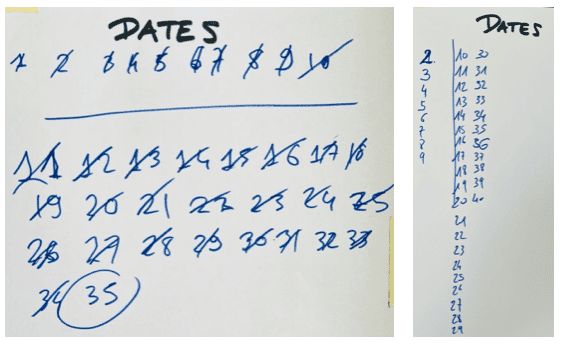
By observing these results, we see that the teams took between 25 and 30 days to depilate what they had stacked in just 10 days.
Even removing 10 days corresponding to the longest time of the last 10 work items, we still remain at a about 30% higher popping time.
He is longer and more painful to depilate a set of elements than stacking them.
The intention is therefore to avoid stacking at all costs.
Previous experiments
3 Rounds, 3 Rules, 10 days
When I started, I had experimented with a version of Featureban with 3 rounds of 10 days each. The idea here was to compare the results produced by only changing the rules in place. We therefore left with a new tableau at the start of each round.
Round 1 was the same as presented previously. Individual focus in an unrestricted system. The result obtained was therefore similar with a trend of flow in a cone, therefore unbalanced. As seen above, this is an unviable (and yet so widespread) strategy.
Round 1: Lots in progress, little done.
Round 2 kept the individual focus but with a limited system. The results here were interesting because the number of completed items was not necessarily higher than in Round 1. However, the flow trend was much more balanced with a contained number of work in progress. It is therefore a viable strategy if we look at the medium to long term.
Round 2: Production of results by limiting waste.
Round 3 injected the collaboration rule into the limited system. The results here are explosive 🙂 Unsurprisingly, this is the most successful strategy!
Round 3: Optimized production by limiting waste.
It's an animation that seems to me always interesting if we want to focus on decision-making rules. Indeed, we are not talking about metrics here, which could be a later step.
Agile Tour Toulouse 2019
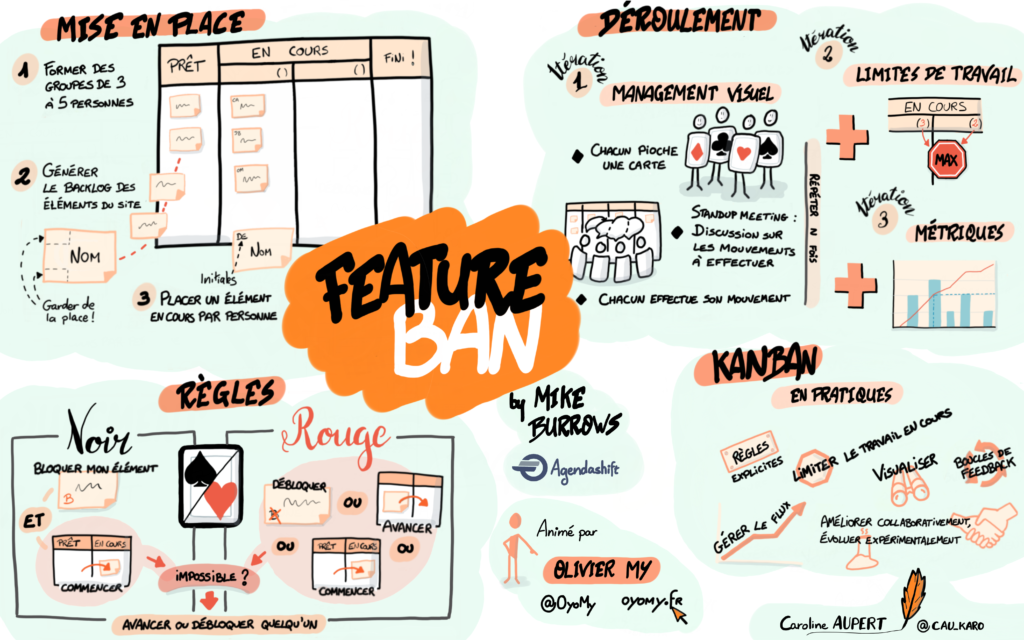
Here is the scribing made by Caroline Aupert on the animation made during the Agile Tour Toulouse 2019.
We can see that there are some differences in terms of animation, in particular the simulation of working days.
Indeed, here no coin tossing but a card draw. If you draw a “Red” card, it corresponds to a good day, if you draw a “Black” card, it corresponds to a bad day. However, the rules of action remain the same. Besides, I had created maps with the rules especially for the occasion.
A difficulty that I have observed is that with a limited number of red cards and black cards, the random aspect is lessened over time. Indeed, the more red cards you draw at the start, the more likely you are to come across black cards later. The idea would have been to make a draw with discount but logistically that did not make the exercise very fluid.
Conclusion

Featureban has become one of my favorite workshops to introduce Kanban. Indeed, it can be animated easily, without too much material and in a short period of time. You can count between 30 minutes and 1h30 depending on what you want to convey.
In particular, it discusses the concepts of visualization, of current work limitation, of metrics, of decision making rules and of feedback loops. It also has the advantage of being flexible enough to be able to focus on a particular message at each session.
I therefore highly recommend it to enhance your range of workshops! Do not hesitate to give me your feedback following experimentation 🙂






